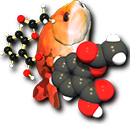Open Babel, or how I learned to love the chemistry file format¶
The latest version of this documentation is available in several formats from http://openbabel.org/docs/dev/.
- Introduction
- Install Open Babel
- obabel - Convert, Filter and Manipulate Chemical Data
- Synopsis
- Options
- Examples
- Format Options
- Append property values to the title
- Generating conformers for structures
- Filtering molecules from a multimolecule file
- Substructure and similarity searching
- Sorting molecules
- Remove duplicate molecules
- Aliases for chemical groups
- Forcefield energy and minimization
- Aligning molecules or substructures
- Specifying the speed of 3D coordinate generation
- The Open Babel GUI
- Tutorial on using the GUI
- Molecular fingerprints and similarity searching
- obabel vs Chemistry Toolkit Rosetta
- Heavy atom counts from an SD file
- Convert a SMILES string to canonical SMILES
- Report how many SD file records are within a certain molecular weight range
- Convert SMILES file to SD file
- Report the similarity between two structures
- Find the 10 nearest neighbors in a data set
- Depict a compound as an image
- Highlight a substructure in the depiction
- Align the depiction using a fixed substructure
- Perform a substructure search on an SDF file and report the number of false positives
- Calculate TPSA
- Working with SD tag data
- Unattempted tasks
- 2D Depiction
- 3D Structure Generation
- Molecular Mechanics and Force Fields
- Write software using the Open Babel library
- Cheminformatics 101
- Stereochemistry
- Handling of aromaticity
- Radicals and SMILES extensions
- Contributing to Open Babel
- Adding plugins
- Supported File Formats and Options
- Common cheminformatics formats
- Utility formats
- Other cheminformatics formats
- Computational chemistry formats
- Molecular fingerprint formats
- Crystallography formats
- Reaction formats
- Image formats
- 2D drawing formats
- 3D viewer formats
- Kinetics and Thermodynamics formats
- Molecular dynamics and docking formats
- Volume data formats
- JSON formats
- Miscellaneous formats
- Biological data formats
- Obscure formats
- Descriptors
- Charge models
- Release Notes
